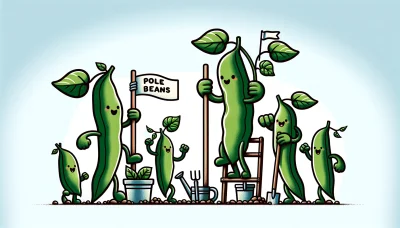Persimmon how to eat Quiz
Test Your Knowledge
Question of
Understanding Persimmons: A Gardener's Guide
Persimmons are a unique and intriguing fruit that have gained popularity among gardeners for a variety of reasons. These fruits, which belong to the genus Diospyros, come in many types but are primarily categorized into two main varieties: the astringent and the non-astringent. The astringent varieties, such as the Hachiya, are known for their tartness when unripe and must be fully soft before eating. On the other hand, non-astringent persimmons, like the Fuyu, can be eaten while still firm. This versatility makes persimmons a favorite among culinary enthusiasts and gardeners alike. Additionally, their vibrant orange color and attractive tree foliage make them a visually appealing addition to any garden. Persimmons are not only valued for their delicious fruit and aesthetic appeal but also for their adaptability to various climates, making them a rewarding choice for gardeners in many regions.
How to Eat Persimmons: A Step-by-Step Guide
- Select the Right Type: Know the difference between astringent (Hachiya) and non-astringent (Fuyu) persimmons to choose the right one for your taste.
- Check for Ripeness: For Hachiya persimmons, wait until they are completely soft and jelly-like. Fuyu persimmons should be firm but with a slight give.
- Wash the Persimmon: Rinse the fruit under cold water to remove any dirt or residue.
- Cut the Persimmon: Remove the leaf-like stem at the top. You can slice Fuyu persimmons like an apple and eat them raw, skin and all. For Hachiya, it's best to cut them in half and scoop out the flesh with a spoon.
- Enjoy the Persimmon: Eat them as is, or incorporate them into salads, desserts, or smoothies. Remember, the skin of Fuyu persimmons is edible, but you may want to peel Hachiya persimmons due to their thicker skin.
- Store Properly: Unripe persimmons can be kept at room temperature until they ripen. Once ripe, they should be stored in the refrigerator to prolong their shelf life.
Choosing the Right Persimmon Variety
Persimmons are a delightful fruit that come in various types, each offering a unique eating experience. Among the most popular varieties are Fuyu and Hachiya. Fuyu persimmons are known for their crisp, sweet taste and can be eaten much like an apple, even when they're not fully ripe. They have a squat shape and are usually bright orange when ready to eat. On the other hand, Hachiya persimmons are larger and more acorn-shaped. They are incredibly astringent if eaten before fully ripe, which means they require patience. Once ripe, their flesh becomes soft and jelly-like, offering a sweet and rich flavor. Choosing between Fuyu and Hachiya persimmons essentially comes down to personal preference and how you plan to use them in your culinary adventures.
The Best Time to Harvest Persimmons
Knowing when persimmons are ripe for harvesting is crucial for enjoying their full flavor and sweetness. The best indicators of ripeness include the fruit's color, texture, and other physical changes. Ripe persimmons typically transition to a deep, vibrant orange or red. The texture becomes softer to the touch, indicating that the fruit's sugars are at their peak. For some varieties, such as the Hachiya, waiting until the fruit is almost jelly-like in softness is key to avoiding astringency. Additionally, the calyx at the fruit's top may begin to recede or loosen when it's ready to be picked. Observing these signs closely will ensure you harvest persimmons at the best time for optimal taste and quality.
Storing and Preserving Persimmons
- Refrigeration: Store unripe persimmons at room temperature until they ripen. Once ripe, transfer them to the refrigerator to slow down the ripening process. Ripe persimmons can last in the refrigerator for up to three weeks.
- Freezing: For longer storage, persimmons can be frozen. Peel and slice them, then spread the slices on a baking sheet to freeze individually. Once frozen, transfer the slices to a freezer bag or container. They can be used for up to a year.
- Drying: Persimmons can be dried in a dehydrator or an oven at a low temperature. Slice the persimmons thinly and place them on the drying racks. Dried persimmons can be stored in an airtight container for several months.
- Making Persimmon Puree: Ripe persimmons can be pureed and then frozen in an airtight container or ice cube trays for easy use in recipes throughout the year.
Innovative Persimmon Recipes for Gardeners
| Recipe Name | Ingredients | Instructions |
|---|---|---|
| Persimmon Salad | Mixed greens, persimmon slices, walnuts, feta cheese, balsamic vinaigrette | Combine mixed greens, persimmon slices, and walnuts. Top with feta and drizzle with vinaigrette. |
| Spiced Persimmon Bread | Ripe persimmons, flour, sugar, eggs, vegetable oil, cinnamon, nutmeg, baking soda, walnuts | Puree persimmons. Mix with wet ingredients, then combine with dry ingredients. Fold in walnuts. Bake at 350°F for 60 minutes. |
| Persimmon Smoothie | Ripe persimmons, banana, almond milk, honey, cinnamon | Blend all ingredients until smooth. Adjust sweetness with honey and serve chilled. |
| Persimmon Pudding | Persimmon pulp, milk, sugar, eggs, flour, baking powder, salt, cinnamon | Mix persimmon pulp with milk and sugar. Beat in eggs. Stir in dry ingredients. Bake at 325°F for 1 hour. |
Growing Your Own Persimmon Tree
Growing your own persimmon tree can be a rewarding experience for any gardener. To ensure success, start by choosing a location that gets full sun and has well-draining soil. Plant your tree during the dormant season, typically in late winter or early spring, to give it the best start. Water your persimmon tree deeply and regularly, especially during dry periods, to encourage deep root growth. Fertilize with a balanced fertilizer after the first year to promote healthy growth and fruit production. Pruning is essential to maintain the tree's shape and to remove any dead or diseased wood. As your tree matures, watch for pests and diseases and manage them promptly to protect your investment. With patience and proper care, you'll be rewarded with delicious persimmons to enjoy from your own garden.












